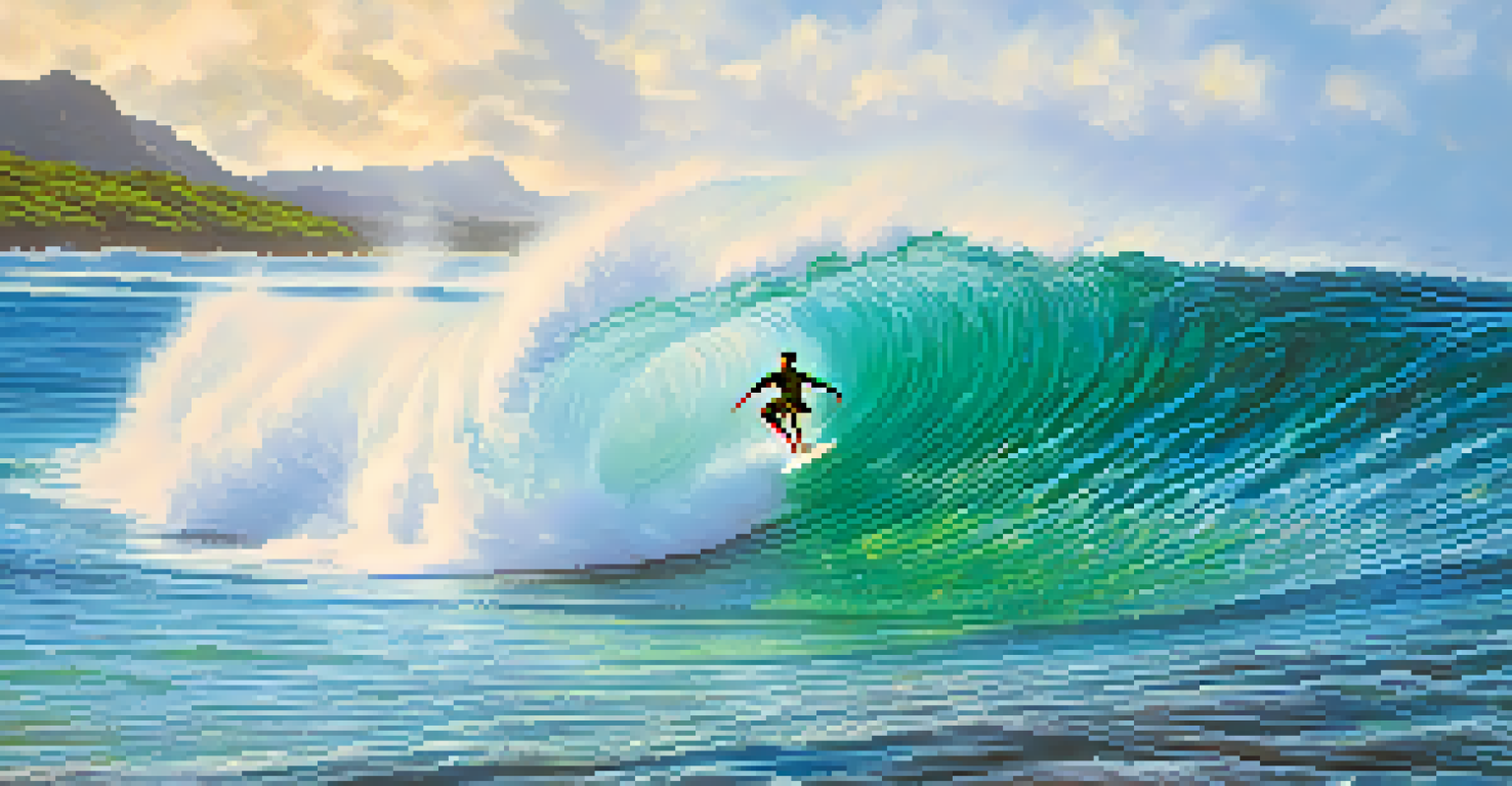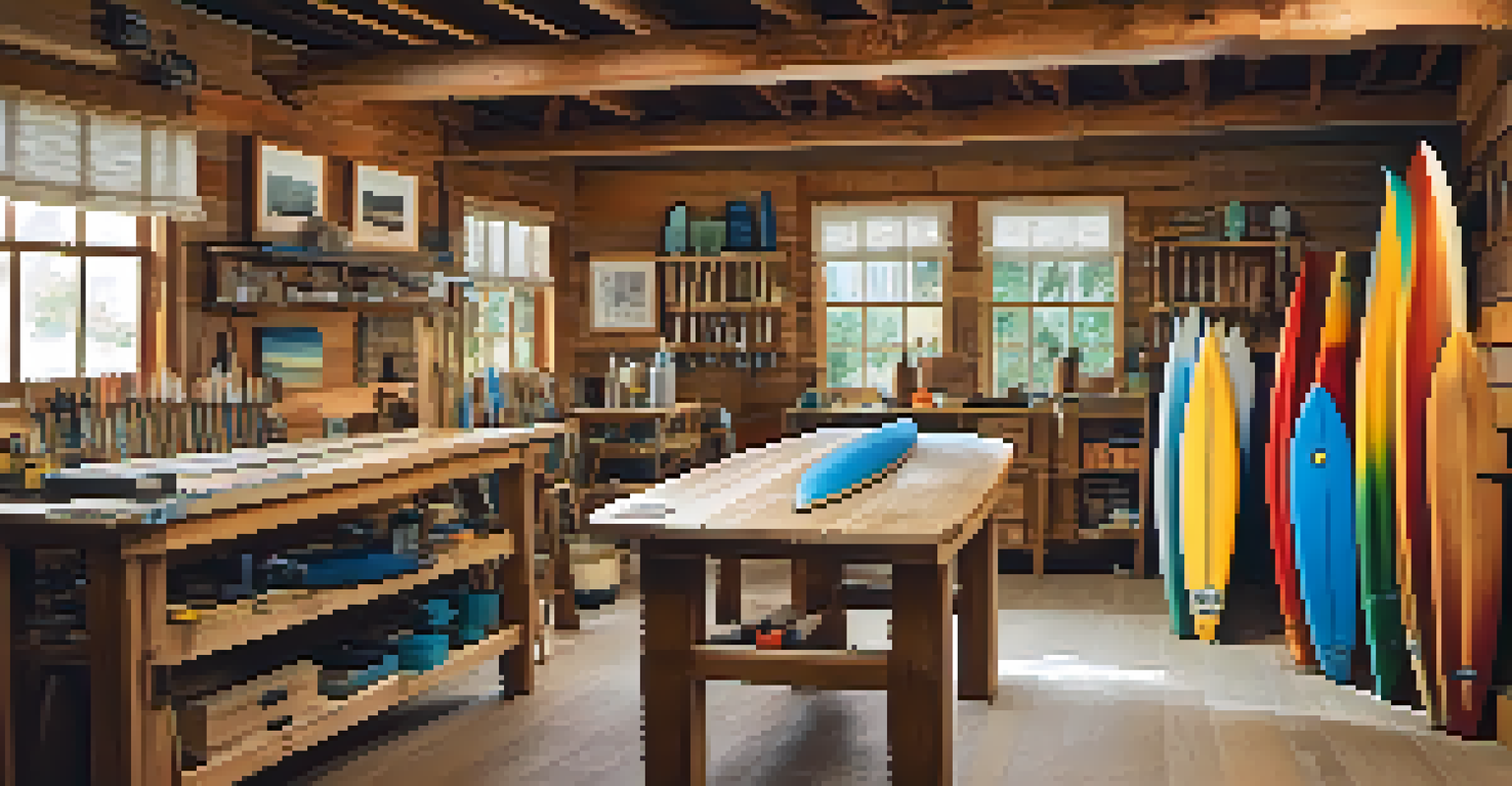The Evolution of Surfing Techniques in Honolulu's Waters

The Ancient Roots of Surfing in Hawaii
Surfing, or 'he'e nalu' in Hawaiian, has deep cultural roots in Hawaii, dating back to ancient Polynesian voyagers. These early surfers used wooden boards crafted from local trees to ride the waves, developing a connection with the ocean that transcended mere sport. Each wave was not just a thrill but a spiritual experience, reflecting the harmony between man and nature.
Surfing is not just a sport, it’s a way of life that connects us to the ocean and each other.
In these early days, surfing was reserved for the ali'i, or chiefs, and their families, highlighting its significance in Hawaiian society. The techniques were rudimentary but effective, emphasizing balance and core strength as surfers navigated the unpredictable waters. This era laid the foundation for what would evolve into a beloved global pastime.
As time passed, surfing spread beyond Hawaii, gaining popularity in various cultures. However, the essence of the sport remained deeply intertwined with its Hawaiian origins, influencing styles and techniques that surfaced in different regions.
The Birth of Modern Surfing in the 20th Century
The early 20th century marked a pivotal shift in surfing, particularly in Honolulu, as innovations began to emerge. With the introduction of lighter materials like balsa wood, boards became more maneuverable, allowing surfers to experiment with new techniques. This era also saw the rise of surfing as a recreational activity, attracting enthusiasts from around the world.

The 1930s brought about the first surf competitions, showcasing the skills of local surfers and increasing interest in the sport. These events not only highlighted individual talent but also fostered a sense of community among participants and spectators alike. This growing camaraderie was crucial in solidifying surfing's place in Hawaiian culture.
Surfing's Rich Hawaiian Heritage
Surfing, deeply rooted in Hawaiian culture, began as a spiritual practice among chiefs and has evolved into a global sport.
As surfing techniques evolved, so did the equipment. The transition from traditional wooden boards to fiberglass revolutionized the sport, creating opportunities for more dynamic and creative riding styles. Surfers began to embrace tricks and maneuvers that were previously unimaginable on heavier boards.
The Influence of Surf Culture and Iconography
Surf culture flourished in the mid-20th century, with the emergence of surf music, fashion, and art significantly impacting Honolulu's surfing scene. This vibrant culture attracted youth, turning surfing into a lifestyle rather than just a sport. The iconic imagery of surfers riding waves became synonymous with the Hawaiian landscape, further embedding the activity into local identity.
The best surfer out there is the one having the most fun.
Films and media played a crucial role in popularizing surfing, showcasing the exhilarating lifestyle that accompanied the sport. Movies like 'Gidget' and 'Endless Summer' captured the imagination of audiences, leading to an influx of aspiring surfers flocking to Honolulu's shores. This phenomenon not only boosted tourism but also transformed local surfing dynamics.
The rise of surf culture also introduced a new wave of techniques, as surfers experimented with different styles influenced by music and art. Longboards, shortboards, and even stand-up paddleboards emerged, each offering unique ways to ride the waves while reflecting individual personality and creativity.
The Emergence of Competitive Surfing
Competitive surfing gained traction in the 1970s, establishing a platform for surfers to showcase their skills beyond informal beach gatherings. Events like the Duke Kahanamoku Classic brought together top surfers from around the globe, elevating the sport's profile and introducing more sophisticated techniques. This competitive environment pushed surfers to innovate and refine their styles.
With the rise of professional surfing, training regimens and coaching became more prevalent, leading to the development of advanced techniques. Surfers began to focus on aerial maneuvers, cutbacks, and tube riding, which were not only thrilling to perform but also visually captivating for spectators. The quest for perfection became a hallmark of competitive surfing.
Competitive Surfing's Evolution
The rise of competitive surfing in the 1970s introduced advanced techniques and training, elevating the sport's profile.
As a result, the sport evolved into a highly technical endeavor, blending athleticism, artistry, and strategy. Surfers like Kelly Slater and Laird Hamilton paved the way for future generations, inspiring young surfers to push boundaries and redefine what was possible on the water.
The Role of Technology in Surfing Techniques
Technology has played an instrumental role in the evolution of surfing techniques over the past few decades. From the introduction of computer-aided design (CAD) in board shaping to the use of advanced materials like carbon fiber, the equipment has become more specialized and performance-oriented. This evolution allows surfers to ride waves with greater precision and control.
Innovations like wave pools and surf simulators have also emerged, providing surfers with unique environments to practice and hone their skills. These technologies allow for year-round training, enabling surfers to perfect their techniques regardless of natural wave conditions. The accessibility of such facilities has transformed how surfers prepare for competitions.
Additionally, wearable technology has entered the scene, allowing surfers to track their performance metrics and analyze their techniques. By combining data with hands-on practice, surfers can identify areas for improvement, ultimately leading to a more refined approach to riding waves.
The Impact of Environmental Awareness on Surfing
As surfing continues to evolve, so does the awareness surrounding environmental sustainability. Surfers in Honolulu and beyond have become advocates for ocean conservation, recognizing the need to protect the very waters they love. This shift has led to the adoption of eco-friendly practices, from using sustainable materials for surfboards to participating in beach clean-ups.
Many surfers now incorporate environmentally conscious techniques into their routines, such as avoiding plastic and supporting eco-friendly brands. This commitment not only helps preserve the ocean but also fosters a deeper connection between surfers and their environment. It’s a reminder that the health of the waves directly impacts the sport they cherish.
Environmental Awareness in Surfing
Modern surfers are increasingly advocating for ocean conservation, incorporating sustainable practices into their sport.
Furthermore, this wave of environmental activism has inspired a new generation of surfers to embrace sustainability as part of their identity. Events focused on conservation and awareness have become commonplace, showcasing how surfing can be a catalyst for positive change in local communities.
The Future of Surfing Techniques in Honolulu
Looking ahead, the future of surfing techniques in Honolulu appears promising, with continuous innovation on the horizon. As new materials and technologies emerge, surfers will likely find even more ways to enhance their performance and creativity on the waves. The blend of tradition and modernity will remain at the forefront, ensuring that the sport honors its roots while embracing change.
Collaboration within the surfing community will also play a critical role in shaping the future. As surfers share knowledge and techniques, they foster an environment of growth and inspiration. This communal spirit is essential for pushing the boundaries of what can be achieved on a surfboard.

Ultimately, the evolution of surfing techniques in Honolulu will reflect the dynamic relationship between surfers and their environment. As awareness of ecological issues grows, future surfers will likely prioritize sustainable practices while continuing to innovate, ensuring that the legacy of surfing lives on for generations to come.